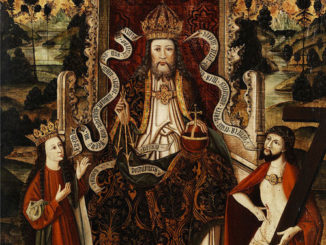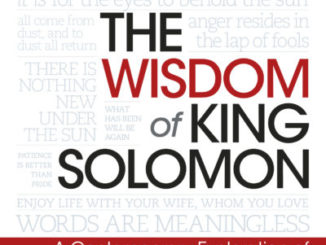
Since time immemorial the philosophical question of the existence of the soul has troubled humanity and many philosophers and theologians have debated the subject. When you think about it, you realize that there must be something in addition to your physical body. The terminology is not important in this discussion and one may equate the word soul to mind or any other word suited to one’s opinion or religion.
The relationship between mind and body and the existence of the soul are the subject of this article.
And the Almighty formed the man of dust from the ground,
and He blew into his nostrils the soul of life (Genesis 2:7)
According to this verse, the soul cannot die. The argument for that claim is that since God blew life into man, He blew it from Himself and since God is eternal and spiritual the soul cannot die as it is part of God. A soul is divine energy or a piece of God within us. King Solomon wrote:
The dust will return to the ground as it was, and the spirit will return to God who gave it (Ecclesiastes 12:17).
Kabbalah in Hebrew means receiving. Kabbalah addresses the nature of the universe and the human beings who live in it. There are many diverse aspects of life, all of which are addressed by Kabbalah. It tries to explain among others the relationship between God the Creator and His mortal creation.
The body is an empty shell and the soul energy is the intelligent energy of creation, which exists everywhere. Being in love and participating in mystical experiences allows us to feel the existence of our soul.
Energy is the communication or the bridge between our body-matter and our spirit-soul. Accordingly, when the soul leaves the body, the body dies, as it cannot exist without the soul. The body has needs, and sometimes it becomes sick.
There are many hopeless medical cases where the patient has had a miraculous recovery, because the soul energy came to help, as it was too soon for the patient to die.
The soul has needs as well. If one attends to those needs, in return the body is healthier. The converse is true as well.
A healthy soul requires a healthy body, as the Latin has it: anima sana in corpore sano. We know that mind and body are connected. Our health is strongly dependent on how we deal emotionally and physically with various situations and conditions. Our immune system is affected when we suffer continuous stress. General illnesses can be largely stress-related. Stress is not always negative, however. Stress is a predictable, normal and sometimes desirable human response. Stress is activated in various circumstances, such as feelings of danger or urgency. In such cases stress protects us by alerting us to danger and keeping us focused.
When stress is continuous and unrelenting, this is the point at which it starts to be harmful. It can have a negative effect in both physical and psychological terms. There is a link between stress and life expectancy. Most researchers believe that stress is a major factor in reducing life expectancy.
The author, however, believes that a certain amount of stress in reaction to certain activities can have the opposite effect. Both ends of the spectrum, namely, no stress at all and extensive stress, are negative factors which influence our way and quality of life. Some stress in a multi-tasking environment, however, can have a positive effect on our life expectancy.
Being active in multi-disciplinary areas not only gives us positive emotions and satisfaction but could also extend our life expectancy.
This assumption is partly supported by the fact that diverse activities mean we activate different brain areas.
Research has shown that negative emotions such as anger and unhappiness have a significant impact on our nervous and immune systems and are probably the cause of certain diseases. On the other hand, positive emotions such as happiness and harmony are elements which have a positive influence on our health.
One way to maintain good health is therefore to adopt a positive mental attitude. As the saying goes: ‘Don’t worry, be happy’.
When scientists speak of the soul outside the cultural, psychological or religious context, they generally treat it as a synonym for the mind. When we can decipher the brain’s functionality, we should learn a great deal about the soul as well. Neuroscience research in the future might reveal the relationship between the soul and the mind and assist our understanding of the soul.
In neurobiology, the material functions of the mind could be a representation of certain mechanistic properties of the brain. The brain essentially shuts down the area which generates conscious thought during deep sleep and reactivates it on dreaming or waking.
The relationship of the brain with the mind is similar to that of computer hardware with software. This analogy of the mind as software is debated by scientists, who claim correctly that the human mind has powers beyond any artificial software.
Time and matter are the most fundamental concepts in physics. Quantum theory has produced many novel insights into these concepts in non-relativistic, relativistic and cosmological contexts.
Time is a subjective entity. Its purpose is to organize events and scenarios in a certain sequential or parallel order. In a different multi-dimensional universe, time may have different meaning, such as events that exist simultaneously.
Such concepts in terms of the theory of relativity can lead us to a hyperspace in a universe beyond space and time. Consequently, death can be viewed as merely a change of phase.
Writings about death are manifold but all are based on speculation and hypothesis. Nobody has died, been cremated or buried and come back to tell the story (I exclude here the Christian claim that Jesus Christ rose from the dead).
Those who compare death to a long sleep do so because we do not have anything else to compare it to.
Many adjectives and images surround the word death: Death is not as many imagine it to be; Death is a temporary state; Death is a transition; Death is beautiful and eternal love, etc. All these comforting descriptions make us, the living, feel good and less afraid or worried about the inevitable end of our physical body and our life as we know it.
A strange phenomenon has been reported by many individuals with regard to what is known as the near death experience.
This phenomenon has appeared in various forms, in different countries and cultures, worldwide. A near death experience (NDE) usually refers to a diverse range of personal individual experiences with multiple strange sensations: out of body experience, feelings of levitation and the presence of a light.
The mainstream scientific community regards such experiences as hallucinations, whereas paranormal specialists and some more maverick scientists would consider NDE as evidence of an afterlife.
Those who ‘came back’ when they were pronounced clinically dead were not really dead; possibly they were on the verge of death but were certainly not dead.
These ‘dead’ people report similar near death experiences. We can conclude from the similarity of those experiences certain things about our brain activity under stress and our self-awareness of approaching death.
There is an evolutionary connection between body and soul. People with a ‘broken heart’ will suffer physical pain. People with chronic pain will say that not only is their body aching but their soul as well.
Reincarnation and the existence of life after death are basic tenets of many religions.
In Judaism, Kabbalah describes the reincarnation of the soul as ‘Gilgul Neshamot’, whereby the soul of the dead person begins a new life in the physical world in a new body. Successive reincarnations allegedly eventually lead to the purification and liberation of the soul.
According to the Talmud (c. 500 C.E.) the soul is brought for judgment after death. The good souls may enter the next world and the bad souls need to be re-educated to enter the next world or the world to come. Some consider this period of re-education as a punishment for wrongdoing.
The concept of eternal damnation adopted by many religions is not widely accepted in Judaism.
Judaism believes that eternal punishment is reserved for a small group of villains and evil leaders, who have committed acts of pure evil against humanity. They will spend time in Hell (Sheol), which has four cells or compartments, for four different categories. The first is for saints who are waiting for resurrection in Paradise, the second is for the virtuous waiting to be rewarded, the third is for the wicked who await punishment, and the fourth is for the wicked who have already been punished. The last are those who will not be resurrected on Judgment Day.
According to Maimonides, a Jewish philosopher of the medieval period, when the soul is separated from the body it continues to live on in spiritual terms and is not physically resurrected. The Zohar (splendour or radiance in Hebrew) is a collection of written thoughts, commentary, and mystical views on the Torah. It serves as the basis for Kabbalah.
The Zohar describes Gehenna as the place of the soul’s purification and not a place for punishment. Plato and other ancient Greek philosophers tried to prove the existence of reincarnation in philosophical terms.
According to Islam, the purpose of the creation of humankind is to worship Allah – the creator of heaven and earth.
Life on earth is a test of each individual before being sent to Jahannam or Jannah, which is Paradise in the afterlife.
In recent years, we may notice the ‘evolution of the soul’ and increase in the need for spiritual nourishment commensurate with the increase in life’s difficulties. Gurus, rabbis, kabbalists and priests alike support this idea. Therapists and pseudo-therapists from diverse fields exploit those needs and weaknesses, usually for monetary gain.
The main purpose of mentioning the above views was to provide a background to the chapter’s subject. It is difficult to argue against religion and belief but as almost all religions believe in the existence of the soul is it possible that all of them are wrong? And if they are right, what is the origin of their belief? Do they have any other sources apart from the Old and New Testaments?
Let us look for a different angle in the search for the existence of something in addition to the physical body.
The following table shows the constituents of a human body weighing 60 kg:
Constituent– Weight– Atoms (%)
Oxygen– 38.8 kg– 25.5 %
Carbon– 10.9 kg– 9.5 %
Hydrogen– 6.0 kg– 63.0 %
Nitrogen– 1.9 kg– 1.4 %
Other– 2.4 kg– 0.6 %
The human body is a living biological system. It can metabolize food and transform it into the energy needed by the body to function.
Its functions include pumping blood, transferring food to all body parts, maintaining body temperature, cleaning the body of undesirable substances, and protecting the body from external and internal injuries and diseases.
It can perform many more complicated functions, such as firing neurons in the brain, storing, processing and retrieving audio-visual and other information and, remarkably, carry and transfer genes to the next generation.
The Hindu religion requires cremation of the body as fire is helpful in transferring the soul to the other world. The Christian faith is not prescriptive, some branches discouraging or forbidding cremation and some permitting it.
The ancient Egyptians had complex and relatively unusual burial customs. They believed that certain procedures were essential to ensure immortality. Accordingly, they performed elaborate mummification and buried the dead with specific artefacts that they might need in the afterlife.
The Jewish faith, especially Orthodox Judaism which strictly follows the laws, forbids burning of the dead and any other form of burial except regular earth burial as they believe in the bodily resurrection.
Albert Einstein spoke about this many times:
I cannot conceive of a God who rewards and punishes his creatures, or has a will of the kind that we experience in ourselves.
Neither can I nor would I want to conceive of an individual that survives his physical death; let feeble souls, from fear or absurd egoism, cherish such thoughts.
I am satisfied with the mystery of the eternity of life and with the awareness and a glimpse of the marvellous structure of the existing world, together with the devoted striving to comprehend a portion, be it ever so tiny, of the Reason that manifests itself in nature.
In a letter of February 5th, 1921 Albert Einstein wrote:
The mystical trend of our time, which shows itself particularly in the rampant growth of the so-called Theosophy and Spiritualism, is for me no more than a symptom of weakness and confusion.
Since our inner experiences consist of reproductions, and combinations of sensory impressions, the concept of a soul without a body seems to me to be empty and devoid of meaning.
In a letter found in the Einstein Archives with Einstein’s hand writing, the following sentence is written:
I do not believe in immortality of the individual, and I consider ethics to be an exclusively human concern with no superhuman authority behind it.
This letter related to a question he was asked as to whether he had considered the relationship of his immortal soul with its creator, and whether he felt assurance of everlasting life with God after death.
In spite of his vigorous denial of the existence of the soul, did Einstein know something that he refused to publish?
The Relativity of Life and Death, perhaps?
This question arises because his famous formula of E=mc2 (where E is energy, m is mass, and c is the speed of light) can be equated to the energy released as the result of cremating a human body.
Quasi-scientific support is often given as evidence that the soul exists. The soul is energy and energy can only be transformed, not disappear.
Therefore, the soul lives on after the death of the body. In cremation, the energy of the body is released as heat.
The ashes generated as the result of cremation of human adults weigh about 2.7 kg (six pounds) for males and 1.8 kg (four pounds) females, and represent about 3.7% of the total body weight.
Cremated remains contain dry calcium phosphates with minerals such as salts of sodium and potassium. In addition, certain gases are released during the process, such as sulphur and carbon, which turn to oxidized gases.
The following experiment was conducted. A dying man, who had left his body for scientific research and believed that his soul would be released after death, was anaesthetized and cremated.
The cremation was held in a completely sealed environment with multiple sensors, including a high-resolution digital video camera. For comparison, two other dead bodies were cremated as well, one by one.
The ashes generated as the result of the cremation were exactly as predicted from the body mass. The heat energy released was measured as well.
The result was amazing!
When all the parameters were calibrated and calculated, the result showed clearly that there was an outburst of unexplained energy when the dying person was cremated.
The equivalent energy released by the two dead bodies was as predicted.
It was obvious that the cremation of the dying person generated some unexplained extra energy.
Was it his soul?
Note: This experiment was performed at a secret location in the author’s feverish brain, deep in his synapses.
Proudly WWW.PONIREVO.COM
by Dr Giora Ram



